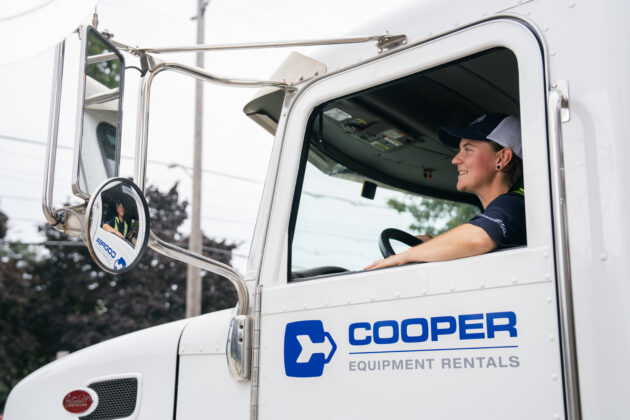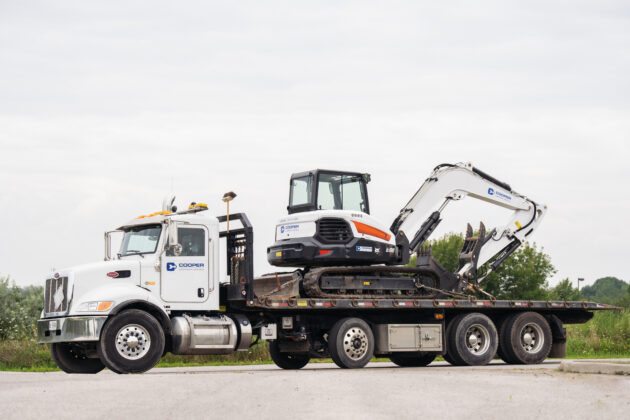
By Darryl Cooper, president, Cooper Equipment Rentals
A safe jobsite starts with safe drivers
Canadian Contractor Project Management Resources COR cor training safety
Photo courtesy of Uptown Media.
An average job site is a busy place with site inspectors, cranes lifting materials into buildings, dump trucks loading and unloading, suppliers and subcontractors delivering equipment. A lot of different people coming and going and a whole fleet of your own equipment in constant movement. The number of things that could go wrong is nearly endless– that is, if you’re not paying attention.
You may have safety requirements in place to mitigate common hazards– hardhats and other PPE, aerial safety harnesses and training around electrocution and slips, trips and falls. You may even have the Certificate of Recognition (COR). But what about the potential hazards that are off-site? Are you protecting your workers (and let’s be honest, your business) by implementing safety practices behind the wheel? Can you be sure they are following the right protocols around speeding, breaking and distracted driving? Are you monitoring your fleet to ensure they are driving safely? And are you encouraging better driver behaviour…or identifying and correcting poor driver behaviours?
Instilling a holistic safety mentality in your employees is essential
There’s always more work to be done when it comes to keeping people safe. It’s a shift from seeing safety as another box to check to one where your company is invested and committed to protecting the wellbeing of workers.
We’ve made safety a pillar of our culture, but our efforts tend to focus on our equipment, our branches and customer sites. Driver and vehicle safety is always hard to measure because of the remote nature of the work. You don’t often realize you have a problem until after the infraction or incident happens. If not effectively addressed the problem could potentially lead to the loss of a commercial operator licence or a compliance audit from the Ministry of Transportation. Your workers may be speeding, driving aggressively or driving while distracted and unless you have tools in place to monitor these behaviours– you may only find out what’s really happening after there is a problem. Left unaddressed you risk big fines and in the worst of cases your people (or others) getting hurt.
When you put a worker behind the wheel of a company vehicle you both take on a lot of risk. Driver behaviour and attitude is critical to performance, both on and off the road. But establishing and maintaining best driving practices takes work. It’s a real change in culture– one that sees safety as an investment, rather than an expense.
Your leadership team needs to be vocal about their commitment to safety and set a good example for themselves. It’s one of the most important factors when it comes to changing company culture and ensuring new processes are understood and followed.
Make sure you’re monitoring your fleet– regardless of size
COR is the gold standard safety program within the construction industry. It’s an extensive system used to both measure a company’s safety management system and integrate safety principles into all aspects of business. I see COR as a foundation for safety culture. It’s going to ensure your team has the right training and safety fundamentals in place. But it’s not always enough– investing in technology to identify, measure and address driver performance is also crucial.
Whether you have five vehicles or 50, monitoring and tracking your fleet is the only way to achieve real results. As the saying goes, “that which gets measured gets done.” Data from your vehicles GPS can provide the needed information to know what is happening on the road, even when there are no incidents. When patterns start to emerge for specific drivers the data can help correct poor driving behaviours before they result in an accident. Having visibility to your fleet allows you to set goals, measure what matters and benchmark it so you can tell what’s working and what’s not.
Fleet monitoring is not about policing your people; it’s a way to identify and reward good driving behaviour while correcting unsafe driver behaviour like harsh braking, excessive speeding and distracted driving. These habits can have a huge impact on the performance, safety and bottom line of your company.

Photo courtesy of Uptown Media.
Place an emphasis on driver training and incentives
Driver training is a given but remember, it’s not a ‘one and done’ kind of thing. You need regular check-ins and upskilling to ensure your drivers understand the unique challenges of operating a company fleet vehicle.
Once your training program is in place and you’re gathering data and information to help monitor driver performance, it’s a good time to introduce incentive and recognition programs.
This is something that’s really worked for us. We’ve got 750 trucks on the road at any given time so measuring performance over the course of the month and year is effective and motivating to our team. We use financial incentives to reward good behaviour and it’s created a fun, healthy competition within the team to see who can get the best safety record. We also publish a list of who has the best safety record and celebrate those safety champions within the company. It’s a great way to promote good behaviour rather than policing bad behaviour.
What do you know about the safety training of your suppliers?
You might be confident in your own safety programs but what about the standards of your suppliers? They’re driving on and off your site in large commercial vehicles, often carrying heavy loads. Are they aware of the jobsite they’re driving into? Are they following safe braking distances and line of sight? Do they have their load secured?
It might be time to become more intentional and discerning in choosing who you work with. COR requires companies to ensure that the suppliers and contractors providing services to their businesses and sights have a robust safety program in place. If they are COR certified, you can be confident that your suppliers are meeting the same safety procedures and standards as your own workers– who know how to proactively identify, evaluate and control potential hazards. A supplier’s actions on your properties can impact the safety of your people, your business and your reputation. The public sector is increasingly requiring COR as a pre-bid qualification for contractors and suppliers. It will be only a matter of time before the private sector follows suit.
Safe driving starts with safe drivers
Finding and retaining qualified workers is a challenge and it’s not getting any easier. Even with proper selection and training, human nature is, what it is. People get distracted and make mistakes. Luckily, new and emerging technology is making the industry safer both for drivers and their employers. When we combine technology like fleet monitoring with safety programs and incentives, we can mitigate these risks and create a safer, healthier and more productive environment for everyone.
- Quebec labour minister tables construction industry reforms
- CONEXPO-CON/AGG launches a mental health resource hub